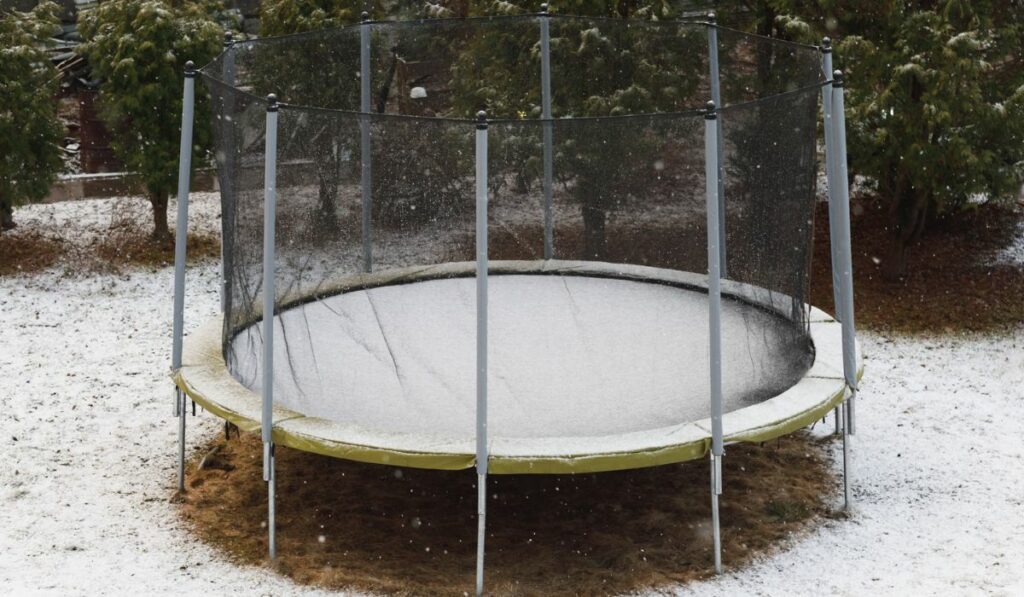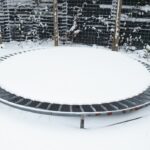As the temperatures drop, trampoline owners wonder if they can leave their trampoline outside or if they need to pack it up and store it inside. This often depends on the storage space available and personal preference—some people like using trampolines in the winter.
You can leave your trampoline outside if you live in an area with low to moderate snow and the winds aren’t too strong. However, if winters are harsh where you live, with heavy snow and high winds, you should disassemble it and store it away.
Jumping on the trampoline, especially in winter, is a great way to exercise instead of holing up inside. But is it safe to leave the trampoline outside? Let’s see when you can cover the trampoline and when you should disassemble it and store it away.
Can You Leave Your Trampoline Outside in the Winter?

Using a trampoline in winter is an excellent way of getting some fun and exercise, but you must be careful when using it in cold weather.
If you usually get lots of snow or experience high winds in winter, it’s better if you don’t leave the trampoline outside. This is because high winds can force the trampoline around your yard and even hurt someone, while the weight of the snow can ruin it.
However, if winters are more moderate where you live, you might not need to pack up and store the trampoline away as the temperatures drop. Typically, the cold alone doesn’t damage the trampoline; exposure to moisture (snow and rain) and high winds can damage it.
When to Cover Your Trampoline
While a trampoline cover tends to lock in moisture and cause mildew and sagging, it’s a good idea to use it if you want to leave your trampoline outside in the winter but expect low to moderate snow. Make sure you check in on your cover 1-2 times a week, and if it looks wet, take it off and dry it.
Which Cover Should I Buy?
Trampoline covers are made of various materials, but the best ones are made using PVC or laminated PE since both provide the ultimate protection. Another thing you need to keep in mind is the grams of thickness each material provides—the higher, the better.
The right size is also essential. Measure the height of the trampoline and the measurement right from the edge to the springs so you can choose a cover that provides full coverage. And finally, make sure it’s in one piece, and you don’t need to add a second cover.
Here are some great options (from Amazon):
- Exacme Trampoline Weather Cover (on Amazon)
- Sihaian’s Cover for 8-15 Feet Trampolines (on Amazon)
- Skywalker Cover for Rectangular Trampolines (on Amazon)
When to Disassemble and Store Your Trampoline
You should disassemble your trampoline and store it indoors if you live in a place where the weather is nasty and harsh. But if dismantling isn’t an option, you can use a cover to keep the debris and dirt off.
And if you get lots of snow, especially heavy and wet snow, make sure you use a broom to remove it from the trampoline’s surface so its weight doesn’t overstretch the springs.
And if high winds are common, anchor down the trampoline using trampoline anchors like these from Eurmax (on Amazon) to prevent it from being blown around the yard.
How to Disassemble Your Trampoline
Most trampolines are made using rust-proof, durable materials and don’t need to be disassembled. However, you should do it if you’re expecting lots of snow.
Since each trampoline is different, the steps to disassemble them vary, and it’s better if you go through the trampoline’s instruction manual to learn how to take it down. But in general, you’ll probably have to do the following:
Wipe it Down
Before you start, use a damp washcloth or towel to clean your trampoline.
Remove and Store Frame Pads
Removing the frame pads can prevent them from being damaged due to moisture. You can easily fold and store them away, and they don’t take up too much space.
Remove Snow from the Jumping Surface
The jumping pad acts as a sieve and allows water to pass through, but heavy snow can build up on it and overstretch the springs, eventually rendering your trampoline useless. When it’s safe enough, use a broom to remove the snow.
Never use a shovel or snowblower since the former can tear or scratch the pad’s surface, while the latter might damage your trampoline if it emits heat.
Remove Safety Netting and Springs
The last thing you must do is remove the springs and the safety netting from around the trampoline. You can leave the metal frame attached to the mat and springs and the poles that keep the net in place, but if you have extra storage space, you can store them with the other pieces.
How to Safely Use Your Trampoline in the Winter
If you choose not to store the trampoline and plan on using it in winter, there are a few safety tips you should keep in mind:
Know How Cold it is
There’s no harm in playing outside in the winter, but children can’t regulate their body temperature as well as adults, and it’s hard for them to judge when they’ve had enough. And as a parent, it’s important to know when it’s time to call them inside.
You should also remember that wind chill can make it feel colder than it is, so make sure you know it is cold outside. And remember not to send your kids outside without appropriate clothing, regardless of their age.
Make Sure it’s Not Snowing
In addition to the weather, ensure your children don’t get on the trampoline while it’s snowing or raining. Moisture (water, ice, or snow) can cause your kids to slip and injure themselves, effectively ending their fun session.
Also, ensure no ice or snow is lingering on the trampoline’s surface from a previous storm. In particular, ice can be hard to detect since it can easily blend with the jump pad.
Look for Damage
Inspect your trampoline (frame, springs, and pads) to ensure the weather hasn’t caused any unexpected damage since it was used. Walk around the trampoline and keep an eye out for areas that look worn out. Make sure to address all safety concerns before letting anyone jump on the trampoline.
Don’t Wear Loose Clothing
Loose clothing like a scarf or an attached hood can be a safety hazard while jumping. Instead, opt for clothes that offer a tighter fit, like a turtleneck or a hat that’s not attached to the clothes. Also, ensure you don’t jump in boots since their rough soles can damage the surface.
Supervise Your Kids

Don’t leave your kids on a trampoline without supervision, particularly in this weather. If the trampoline is large enough, you can join in on the fun. Otherwise, you can keep yourself warm with toe warmers. Make sure you watch your kids closely for any signs of them getting cold, and take them inside in time.








